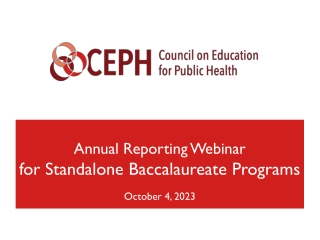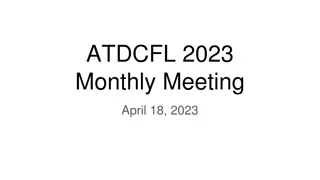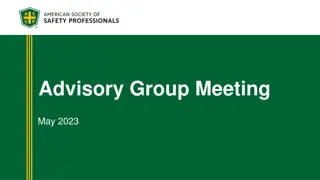
Maxillofacial Trauma Management
Maxillofacial trauma involves injuries to the face, with varying causes such as accidents, assaults, falls, and more. This article discusses the etiology, management approaches, including the principles of ATLS, and the importance of quick and efficient care to improve patient outcomes.
Download Presentation

Please find below an Image/Link to download the presentation.
The content on the website is provided AS IS for your information and personal use only. It may not be sold, licensed, or shared on other websites without obtaining consent from the author. If you encounter any issues during the download, it is possible that the publisher has removed the file from their server.
You are allowed to download the files provided on this website for personal or commercial use, subject to the condition that they are used lawfully. All files are the property of their respective owners.
The content on the website is provided AS IS for your information and personal use only. It may not be sold, licensed, or shared on other websites without obtaining consent from the author.
E N D
Presentation Transcript
Maxillofacial trauma Dr.Mohammed Alaraji B.D.S.F.I.B.M.S
maxillofacial trauma can involve any part of the face and it can have serious effects on both the function and esthetics of the face. The incidence of maxillofacial trauma varies from country to country (and even within the same country), depending on several factors, including the geographic area, the socioeconomic status, the cultural background, alcohol and drug abuse, road traffic legislations and seasons.
Etiology 1. Road traffic accidents (RTA). 2. Assaults and interpersonal violence. 3. Fall. 4. Sport-related injuries. Work-related accidents. 5. 6. Gunshot or missile injuries.
Preliminary management of maxillofacial Mortality from trauma has a trimodal distribution with three clearly defined peaks 1. The first peak in mortality is within seconds or minutes of the event,when the degree of injury received is the most severe such as severe injury to the brain and the major cardiovascular structures, such as the heart and great vessels. 2. The second peak occurs some minutes to 1 or more hours after the event. Death is attributed to unrecognized serious complications, such as airway compromise, hemorrhage, and head injury. The golden hour of care after injury is characterized by the need for rapid assessment and resuscitation. 3. The third peak occurs days to weeks after the event, when sepsis or multiorgan failure occur and lead to death.
Advanced trauma life support (ATLS) This term was developed by the American College of Surgeons Committee of Trauma to ensure a quick and efficient evaluation of the patient's injuries and almost-simultaneous life saving intervention.
The principles of( ATLS) A. Airway with cervical spine control B. Breathing and ventilation C. Circulation and hemorrhage control D. Disability due to neurological deficit E. Exposure and environment control
Airway and cervical spine control All patients who have been subjected to maxillofacial or head trauma should be presumed to have sustained a cervical spine injury until proven otherwise. The cervical spine should be immobilized in the neutral position by means of a semirigid cervical collar or spinal board until definitive radiographs showing all seven cervical vertebrae and the first thoracic vertebra are taken to rule out cervical injury.
Techniques to provide an unobstructed airway A fully conscious and upright patient is usually able to maintain an adequate airway. A careful examination of the oral cavity should be made, any dentures or portions of broken dentures should be removed together with any avulsed teeth, or loose or broken teeth that are so mobile there is a risk of their being inhaled in addition to suction of secretions, blood and mucus to clear the airway. Chin lift and jaw thrust help improve the airway, but may be difficult to do in a conscious patient with mandibular fractures. Jaw thrust involves placing the fingers behind the angle of the mandible to push the jaw forwards and upwards while the thumbs push down on the chin or lower lip to open the mouth.
Temporary reduction and stabilization of anterior mandibular fractures with a (stay or bridle wire) around stable teeth on either side of the fracture if possible can reduce bleeding and support the mandible. Collapsed maxillary fractures may cause airway obstruction. It can be displaced backwards and downwards along the inclined surface of the relatively thick skull base, resulting in impaction of the soft palate into the pharyngeal space. The maxilla should be gently repositioned to maintain the airway and control hemorrhage. Insertion of oropharyngeal or nasopharyngeal airway can secure the airway. Endotracheal intubation is necessary to secure airway if the patient has more severe damage, cannot maintain the airway, requires ventilation. Emergency surgical airway is required when the airway cannot be secured by any other means. Surgical airway is obtained by cricothyroidotomy (also known as cricothyrotomy) or tracheostomy.
Cricothyroidotomy is the fastest and safest method of obtaining a surgical airway. Needle cricothyroidotomy is a temporary procedure that is used to oxygenate patients (for approximately 45 minutes) while a definitive airway is being quickly prepared, in this procedure a cannula is introduced into the lumen of the trachea through the cricothyroid membrane to deliver oxygen.
Tracheostomy an incision is made halfway between cricoid cartilage and suprasternal notch, dissection continues down to the 2nd and 3rd tracheal rings, then a window is excised through the trachea and the tracheostomy tube is inserted and secured.
Indications for tracheostomy in maxillofacial injuries When prolonged artificial ventilation is necessary . To facilitate general anesthesia during surgical repair of complex facial injuries. To ensure a safe postoperative recovery after extensive surgery. Following serious hemorrhage into the airway, particularly when a further secondary hemorrhage is a possibility.
Breathing and ventilation Once airway is secured, the efficiency of breathing and ventilation must be assessed by auscultation and chest radiographs. Serious chest injuries that compromise ventilation are: Pneumothorax which develops from damage to the chest wall or laceration of the lung pleura, with a resulting loss of negative intrapleural pressure, it can be: open, closed or tension pneumothorax. Hemothorax is the collection of blood in the pleural cavity.
Flail chest occurs when three or more adjacent ribs are fractured in at least two locations, resulting in a freely moving segment of chest wall during respirations. Diaphragmatic rupture may result in herniation of intraabdominal contents into the chest. This herniation results in compression of the lung and displacement of the mediastinum to the contralateral side, followed by marked respiratory distress, cyanosis, and hypotension. Aspiration Aspiration of teeth, dentures, vomit and other foreign materials. In this case endoscopy may be necessary to remove denture fragments or other foreign bodies.
Circulation and hemorrhage control Definitive bleeding control is essential, along with appropriate replacement of intravascular volume. The majority of fractures of the facial skeleton are relatively closed injuries and life-threatening hemorrhage is uncommon and hemorrhagic shock is unusual but clinically significant blood loss can occur in patients with panfacial fractures.
The parameters reflecting the degree of hypovolemia Tachycardia; defined as heart rate greater than 100 beats/min in an adult. Hypotension Tachypnea Delayed capillary return Falling urinary output Deteriorating mental status (i.e., increasing confusion
Method of bleeding control direct manual pressure on the wound or by suturing. Obvious bleeding vessels should be secured with artery forceps, ligated if possible. bleeding can occur from grossly displaced fracture of the mandible or midface, this can be controlled by manual reduction of the fracture and temporary immobilization either manually, or by means of a stay wire. Epistaxis occurs due to injury to the middle third of the face, it usually stops spontaneously or is easily controlled by lightly packing the nose (anterior nasal packing). ligation of the vessels .
Disability due to neurological deficit A rapid assessment of the patient's neurological disability can be made by noting the patient's response on the four-point AVPU scale: A Alert. V Voice, able to respond to verbal command. P respond to painful stimuli. U Unresponsive.
Exposure and environment control All trauma patients must be fully exposed. Therefore the environment must be warm and appropriately protected to ensure that the patient suffers no further harm by being exposed to the surrounding ambient temperature. The patient should be fully examined including an examination of the back, if necessary, by using a logroll technique to ensure that otherwise hidden areas have been inspected.
It is important at all stages of the management of the trauma victim that reassessment is regularly carried out to ensure that the patient is still stable and to detect any early deterioration. This head-to-toe examination involves examination of all body systems. Once the patient is stabilized and after adequate resuscitation a detailed assessment of the level of head injury is made using a combination of the pupil reactions and the Glasgow Coma Scale.
Glasgow coma scale It is a method of neurological assessment of the level of consciousness; it provides a reliable, objective way of recording the conscious state of a patient. It can be used for initial evaluation as well as regularly recording improving or deteriorating status. Points are awarded using the criteria given in the scale to give a total score between 3 (deeply unconscious and unresponsive) and 15 (fully conscious, alert and orientated). Any patient with a GCS score of less than 8 should be considered as unable to protect their airway.
Best eye response (E) Consists of 4 grades : Grade 4 Spontaneous eye opening. Grade 3 Eye opening in response to command. Grade 2 Eye opening in response to painful stimulus grade 1 No eye opening.
Best verbal response (V) Consists of 5 grades:, 5. Orientated; coherent and appropriate response to questions. 4. Confused conversation. 3. Inappropriate words 2. Incomprehensible sounds. 1-No verbal response...
Best motor response (M) Consists of 6 grades:, 6- Obeys command. 5. Localizes to pain. 4. Flexion/withdrawal to pain. 3.Abnormal flexion (decorticate posture). 2.Abnormal extension (decerebrate posture). 1. Makes no movements















